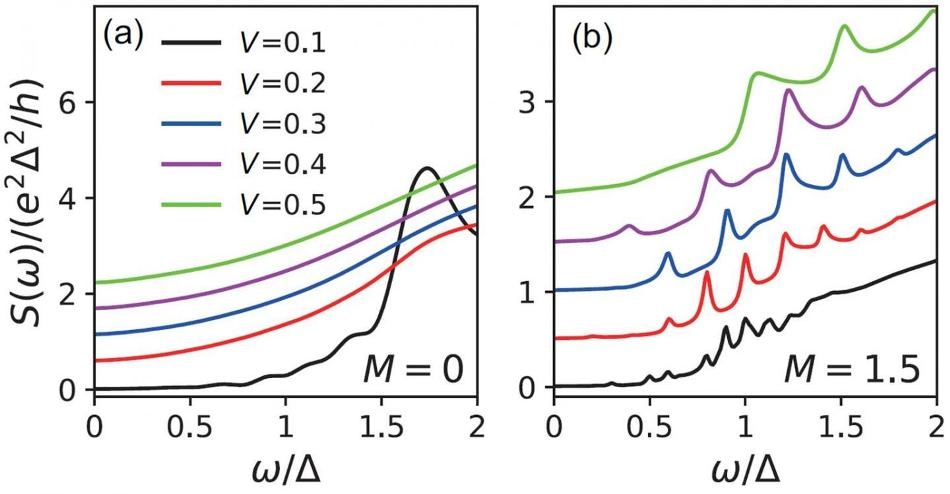Jul 27 2018
The antiparticle of a Majorana fermion, a type of particle, is itself. In the field of condensed matter physics, zero-energy Majorana fermions conform to non-abelian statistics and can be used in fault-tolerant topological quantum computation.
 This is the non-equilibrium noise at a finite frequency for various values of the applied bias voltage for a topological Josephson junction with two different transmission probabilities D = 1 (a) and D < 1 (b), respectively. The peaks in the right figure uncover the existence of the Majorana fermions. (Image credit: Science China Press)
This is the non-equilibrium noise at a finite frequency for various values of the applied bias voltage for a topological Josephson junction with two different transmission probabilities D = 1 (a) and D < 1 (b), respectively. The peaks in the right figure uncover the existence of the Majorana fermions. (Image credit: Science China Press)
Consequently, they have been extensively studied. However, since no electronic charge is carried by Majorana fermions, it is highly difficult to detect them experimentally. A latest current noise research offers a direct technique for detecting these innovative particles.
The paper titled “Current noise in a topological Josephson junction” has been published in SCIENCE CHINA Physics, Mechanics & Astronomy. The corresponding authors of the paper are Professor Hua Jiang from Soochow University and Professor X. C. Xie from Peking University. The researchers used non-equilibrium Green’s function technique to analyze the current across a topological Josephson junction and related current noises, thereby disclosing the relation between the presence of Majorana fermions and the non-equilibrium current noises.
Researchers have proposed that if the time reversal symmetry is broken, a topological Josephson junction would have the ability to host two zero-energy Majorana bound states at its interfaces. The presence of these states produces to two 4π periodic energy-phase relations in correspondence with two different parities and intersecting with each other. Energy-phase relations such as these result in a fractional Josephson effect of the same periodicity.
However, in a realistic system, the 2π periodicity is restored by the infinitesimal energy gap opened by the finite-size effect. In a non-equilibrium state, the Majorana bound states may overcome this energy gap under a bias voltage V. Theoretical studies proposed that the current noise exhibits a peak at ω = eV as a result of the coupling between Majorana bound states and the continuum. However, these Majorana bound states could also couple the continuum following a multiple Andreev reflections process at the interfaces. This will lead to some innovative phenomena.
Using the non-equilibrium Green function technique, scientists investigated the effect of the multiple Andreev reflections in the absence as well as in the presence of a DC bias voltage. They demonstrated that the equilibrium current and the equilibrium noise present the same 2π periodicity as those in traditional junctions as a result of the finite-size effect. However, the decreases in the equilibrium noise show the signature of the fractional Josephson effect. In contrast, the multiple Andreev reflections-induced peaks of the finite frequency non-equilibrium noise that emerged at ω = neV offer a proof for these Majorana bound states to be experimentally detected.
The National Key Basic Research Program of China (Grant Nos. 2015CB921102, and 2014CB920901), the National Key Research and Development Program of China (Grant No. 2017YFA0303301), and the National Natural Science Foundation of China (Grant Nos. 11574007,11574245, 11534001, and 11474085) supported this study.